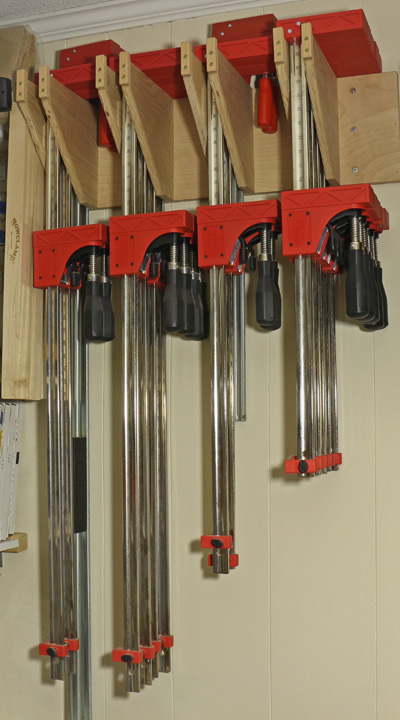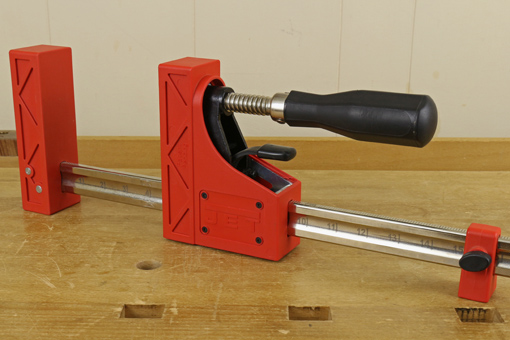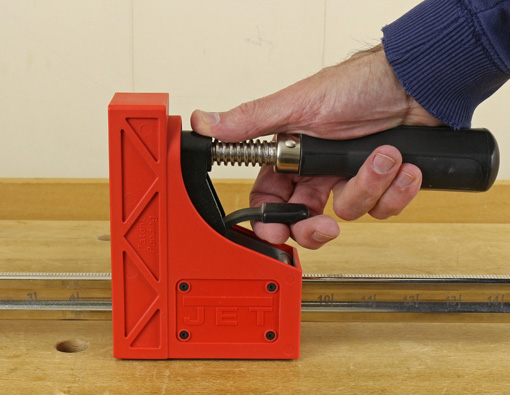
What task produces some of the tensest moments in woodworking? Gluing up, right? And what are the main tools we use for that task? Clamps. Yet there usually is not much discussion about them, many woodworkers skimp on them thinking they’re not real tools, and they generally just don’t get much respect.
Let’s start with long clamps – bar clamps, carcass clamps, whatever you want to call them – that are mostly used to edge glue boards, clamp post and rail assemblies such as for a table, and glue up carcasses. This discussion refers to clamps where the contact part of the head starts right at the bar; not F style clamps.
I used 3/4″ pipe clamps for this for a long time – too long. They have the advantage of economy, especially because longer clamps are made by simply swapping the heads onto longer pipes. However, even with special supports and pads, they just cannot be used with the same reliable precision as parallel-head bar clamps.
Precision? For clamps? Yes. At crunch time, clamping precision matters. We use precision tools like squares, pinch rods, and straightedges to accurately assess a case or leg-and-apron assembly, looking for tiny gaps and misalignments. Doesn’t it make sense to invest in accurate tools to adjust and hold those parameters at the moment when it really counts and when there’s no going back?
As with most topics on this blog, I will tell you what I use and why, hoping this will be helpful to readers making choices and solving problems in their shops. I cannot offer comprehensive comparative reviews like in the magazines, just real stuff from years in my shop.
My favorite parallel clamp is the Jet. Bessey also make excellent clamps – I have some of their older model – and there are others including Jorgensen and Irwin. An alternative is the aluminum bar clamp by Universal Clamp Company, which is a precise clamp with the advantage of much lighter weight. Though a good choice for lighter work, these eventually lost out in my shop to the more versatile Jets, which are more rigid and deeper.

To open the Jet clamp, the head is released to slide freely without catching by lightly pulling up on a lever under the handle. The head can be advanced to close the clamp without using the lever. I really like how the thread action engages immediately when the head is set into position. There is no lag or confusing need to lift or lower the handle for any of this.

The long side of the firm, glue-resistant head extends more than four inches. In some situations, the work piece can also be placed on the side of the bar or under the short side of the head where there is about ⅝” extension. I like the large diameter handles that give good moment when tightening. To really sock down, use grippy gloves.
The inch scale on the bar is handy when readying a bunch of clamps, such as in edge joint glue ups. There is also a simple moveable support for the bar.
More to come on clamps and clamping.


I’ve been reading your blog for some time and I’ve found many of your topics very interesting. Keep up the good work. We are paying attention…
I took your Jet Parallel clamp recommendation to heart and purchased a pair of 31″ and a pair of 40″ during a recent 50% off sale. I’d like to add a couple comments as I also own a pair of Bessey 24″ parallel clamps. First, the Jet clamps are larger and of course heaver which for me is not an issue and I like the added size and weight for most tasks. You are spot on with the lever release as this is much better than the Bessey configuration and more intuitive to boot. The numbers on the side are really helpful for presetting the clamps and the bonus sliding foot at the end helps with keeping the clamps pointed upright and the head slightly lifted even if the setup table is a bit shorter than the clamp bar. The Bessey’s have a plastic tab on the ends but it is not movable.
I have two comments about the overall quality of the clamps. Let me state upfront, I’m being very picky here and it did not deter me from making my purchase. First, the screw is not machined. This makes for a rather sloppy fit but I have not incurred any issues with the clamps ability to hold or any thread stripping. The Bessey screws are machined but the constant jacking around with the handle to engage the bar lock is a real pain.
Second is the handle. To be honest, the shape and size is great for me and you can get some serious leverage on it. It was a real selling point for sure so what’s the problem? Well, due to my own fault, one of the 40″ clamps fell off the bench onto the concrete floor and snapped the handle right off. It was then that I could see the real issue. The metal screw only protrudes about 3/4″ in to the handle and the handle is a type of plastic that has small air pockets in it to save on material and weight. It would appear that there is very little material actually surrounding the screw so it’s no wonder it broke off.
But I’m not going to end this on a bad note. I was able to contact Jet and get a replacement (the entire adjustable clamp assembly) for free. I didn’t even have to pay for shipping. The tech mentioned the clamps have a lifetime warranty as long as you can show proof of purchase. The replacement arrived in less than a week and replacing the head took about 30 seconds.
I’ll need to be a more careful in the future but overall, I’m really happy with them and will purchase more as the need arises. I’ve recommend these to many of my friends as well. Thanks for the recommendation Rob.
Mike
Thanks, Mike, good info. I’m glad the clamps are working out for you. Gee, I think I’d have bought more of them at 50% off!
A few things I’d add. The Jet and Bessey clamps of the same length feel about the same weight to me.
Though the Jet threads are not machined, I’m not sure about the older Besseys that I have because they are coated with a black finish, but anyway the threads do look cleaner than the Jet’s. Both brands use sturdy trapezoidal (acme) threads and neither housing is machined as far as I can tell so there’s plenty of play in both, though a little less in Bessey’s. As you note, the play causes no functional problem.
It’s great that Jet replaced the handle but it does seem to be a weak spot.
Rob